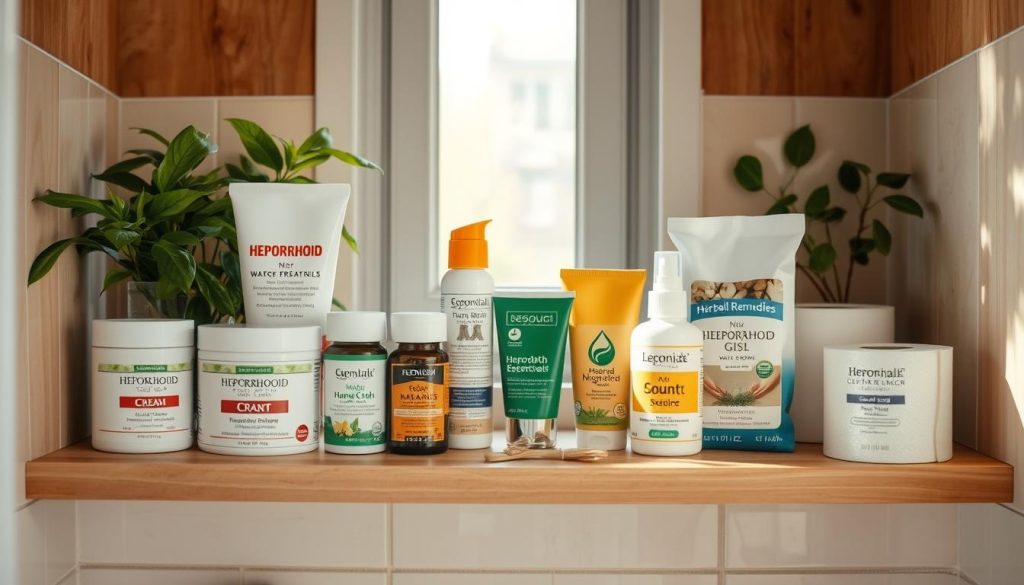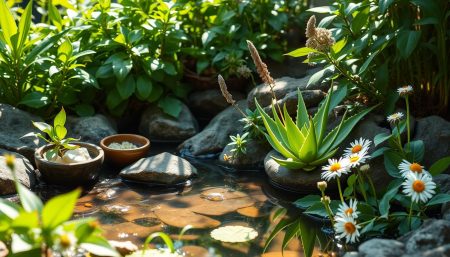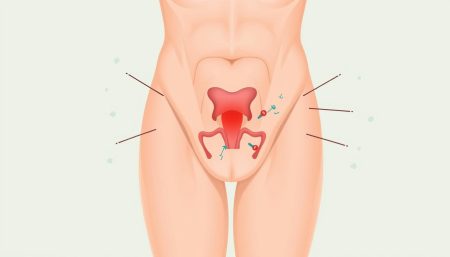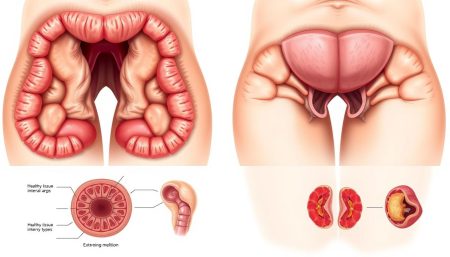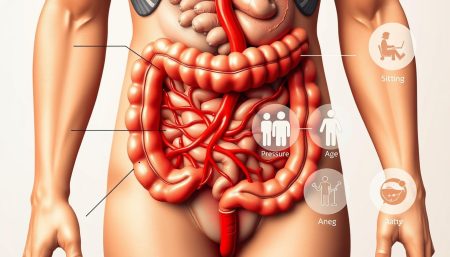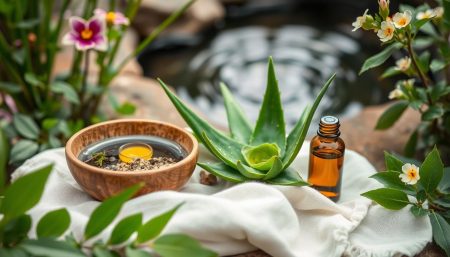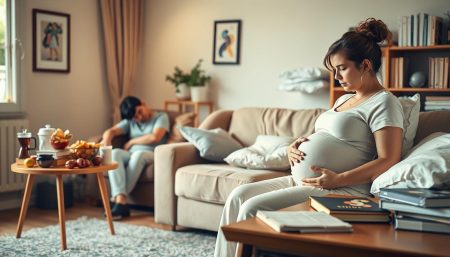Dealing with hemorrhoids can be tough, but knowing your options is key to feeling better. This Quick Relief Guide covers effective treatments and relief methods for hemorrhoids. Each tip is designed to offer quick comfort and help manage symptoms over time.
Whether it’s changing your diet, making lifestyle adjustments, or seeking medical help, we’ve got you covered. This guide offers a complete approach to tackling hemorrhoid symptoms.
Key Takeaways
- Understand the wide range of hemorrhoid treatment options available.
- Discover immediate hemorrhoid relief methods that can be used at home.
- Gain insight into long-term strategies for managing hemorrhoid discomfort.
- Learn the importance of a personalized approach to treating hemorrhoids.
- Explore both at-home remedies and professional medical interventions for hemorrhoids.
- Recognize the value of a holistic perspective in hemorrhoid management.
Understanding Hemorrhoids and Their Causes
Hemorrhoids are swollen veins in the anal or rectal area. They affect millions worldwide. Knowing the causes and how to prevent them is key to treating them well.
Discomfort from hemorrhoids comes from too much pressure in the pelvic and rectal areas. This pressure can come from straining during bowel movements, sitting for long times, being overweight, being pregnant, or eating a diet low in fiber.
- Straining during bowel movements
- Prolonged sitting
- Obesity
- Pregnancy
- Low-fiber diet
Hemorrhoids grow and get worse because of the pressure on veins. This pressure makes blood pool in veins, causing them to swell and get inflamed.
Understanding the biology and pathology behind hemorrhoids is crucial for effective prevention and treatment strategies.
| Cause | Impact on Hemorrhoids | Preventive Measures |
|---|---|---|
| Straining during bowel movements | Increases pressure in rectal veins | High-fiber diet, adequate hydration |
| Prolonged sitting | Stagnation of blood flow | Regular breaks and light exercise |
| Obesity | Extra pressure on pelvic veins | Weight management and healthy diet |
| Pregnancy | Pressure from the growing uterus on veins | Regular physical activity, pelvic floor exercises |
| Low-fiber diet | Leads to harder stools and straining | Diet rich in fruits, vegetables, and whole grains |
Understanding these factors helps people make better choices for treating hemorrhoids. They can take steps to prevent them by addressing the root causes.
Symptoms of Hemorrhoids That You Should Not Ignore
Knowing the signs of hemorrhoids is key to getting the right treatment early. Both external and internal hemorrhoids have different symptoms. Spotting these signs early can help you use natural remedies and stop the condition from getting worse.
Recognizing External Hemorrhoids
External hemorrhoids are easy to spot because they’re around the anus. You might notice:
- Noticeable lumps or swelling around the anus, which can hurt when touched.
- Persistent itching and discomfort in the anal area.
- Pain gets worse when sitting or during bowel movements.
- Occasional bleeding when wiping.
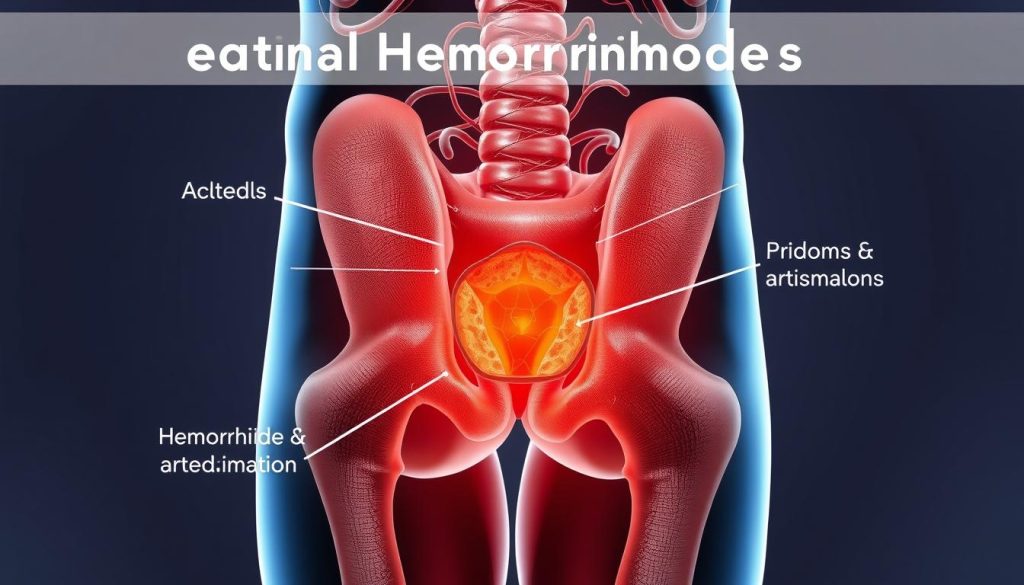
Identifying Symptoms of Internal Hemorrhoids
Internal hemorrhoids are harder to see but have clear signs, like:
- Feeling of fullness in the rectum, without pain.
- Bleeding during or after bowel movements, seen as bright red streaks on toilet paper.
- A prolapse, where hemorrhoid tissue falls out of the anus during bowel movements, needing to be pushed back.
Both types of hemorrhoids can be uncomfortable and affect your life. Using natural remedies and trying different home treatments can help. But knowing what kind of hemorrhoids you have is the first step in finding the right treatment.
Initial Steps for Managing Hemorrhoid Discomfort
Dealing with hemorrhoids can be tough, but starting with simple steps can help a lot. Learning how to ease hemorrhoid pain relief and hemorrhoid treatment at home can make you feel better. It also helps prevent future problems.
Keeping your hygiene gentle is very important. Use soft, unscented toilet paper or pre-moistened wipes. This helps avoid making the problem worse when you clean the area.
- Avoid Straining: Don’t push too hard when you go to the bathroom. This can help reduce pain and discomfort.
- Comfortable Seating: Use a cushion or a hemorrhoid pillow when sitting. It helps relieve pressure and pain.
- Appropriate Clothing: Wear loose, breathable clothes. This prevents friction and keeps the area dry, reducing irritation.
| Activity | Recommendation |
|---|---|
| Bathing | Take warm baths without soap, or use a sitz bath for 15 minutes several times a day. |
| Diet Modification | Eat more fiber to make stools softer. This makes it easier to pass without straining. |
| Physical Activity | Do gentle exercises like walking or swimming. This improves blood flow and prevents constipation. |
By following these simple tips, people with hemorrhoids can manage their symptoms better at home. Focusing on gentle practices is key to effective hemorrhoid treatment at home. But remember, these steps are not a replacement for professional medical care.
Hemorrhoid Home Remedies for Immediate Relief
Looking into hemorrhoid home remedies can really help with the pain. Warm baths and DIY fixes like sitz baths and cold packs are great for easing irritation and pain at home.
Warm Baths for Soothing Irritation
Warm baths can calm down the irritated areas around your anus. They help with healing and make you feel relaxed. The warmth also improves blood flow and eases tightness.
DIY Treatments: Sitz Baths and Cold Packs
Sitz baths warm up the affected area, which is good for painful or itchy hemorrhoids. Cold packs, on the other hand, reduce swelling and numb the pain with cold.
Using these treatments together can really help. They not only ease the pain but also speed up healing. That’s why they’re smart choices for hemorrhoid home remedies.
Here’s a table showing how different home treatments compare:
| Treatment Type | Benefits | Usage Guidelines |
|---|---|---|
| Warm Bath | Soothes irritation, aids circulation | Submerge for 15-20 minutes, warm water |
| Sitz Bath | Directly targets affected area, reduces itching | Use sitz bath kit, sit for 15 minutes with warm water |
| Cold Pack | Reduces inflammation, numbs pain | Apply intermittently for 5-10 minutes |
These simple hemorrhoid treatment at home methods can give you quick relief. They help improve your life without needing a doctor’s help.
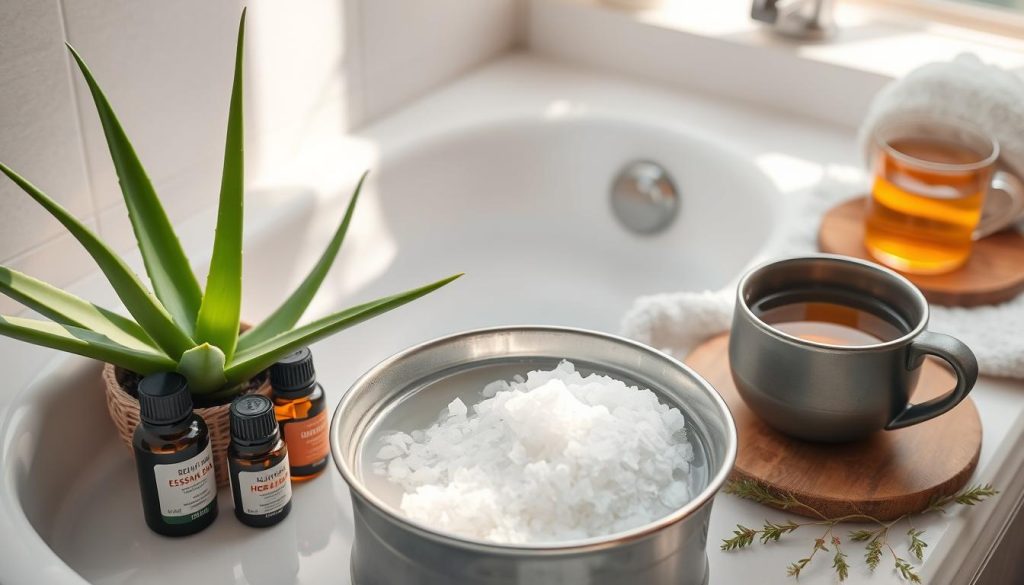
how to treat hemorrhoids With Dietary Changes
Nutrition plays a big role in managing and preventing hemorrhoids. Making dietary changes is a key part of finding the best treatment for hemorrhoids. Eating the right foods can help reduce the pain and discomfort of this condition.
Eating a high-fiber diet is a top natural remedy for hemorrhoids. Fiber makes stool softer and bulkier. This helps prevent straining, which can make hemorrhoids worse. Foods high in fiber include fruits, vegetables, whole grains, and legumes.
| Foods to Increase | Foods to Avoid |
|---|---|
| Whole grains (e.g., oats, brown rice) | Processed foods high in refined sugars |
| Leafy greens (e.g., spinach, kale) | Red meat and dairy products that can lead to constipation |
| Legumes (e.g., beans, lentils) | Fried foods and heavy gravies |
| Fruits such as pears and apples | Alcohol and caffeine which can irritate the gut |
Drinking enough water is key to ease bowel movements and lower the risk of hemorrhoid flare-ups. Staying hydrated supports digestive health and helps prevent constipation, a major cause of hemorrhoid pain.
Changing how often and how much you eat can also help. Eating smaller, more frequent meals helps keep digestion steady. This prevents the digestive tract from getting too full, which can increase pressure and strain.
For more detailed insights into managing health conditions through dietary choices, consider exploring the benefits of these approaches for allergic rhinitis. It also focuses on avoiding triggers and making lifestyle changes for long-term relief.
Over-the-Counter Products That Help Ease Hemorrhoid Symptoms
Looking for hemorrhoid relief methods? Over-the-counter products can help a lot. They include topical ointments and dietary supplements. These are made to give quick and effective hemorrhoid pain relief.
Topical Ointments and Creams
Topical treatments are a good start for dealing with hemorrhoid pain. Hydrocortisone creams reduce swelling and irritation fast. Witch hazel creams cool the area and help with burning.
Stool Softeners and Fiber Supplements
Keeping bowel movements smooth is key in fighting hemorrhoids. Stool softeners and fiber supplements are very helpful. They make stool softer, easing the pressure during bowel movements. This helps prevent flare-ups and pain.
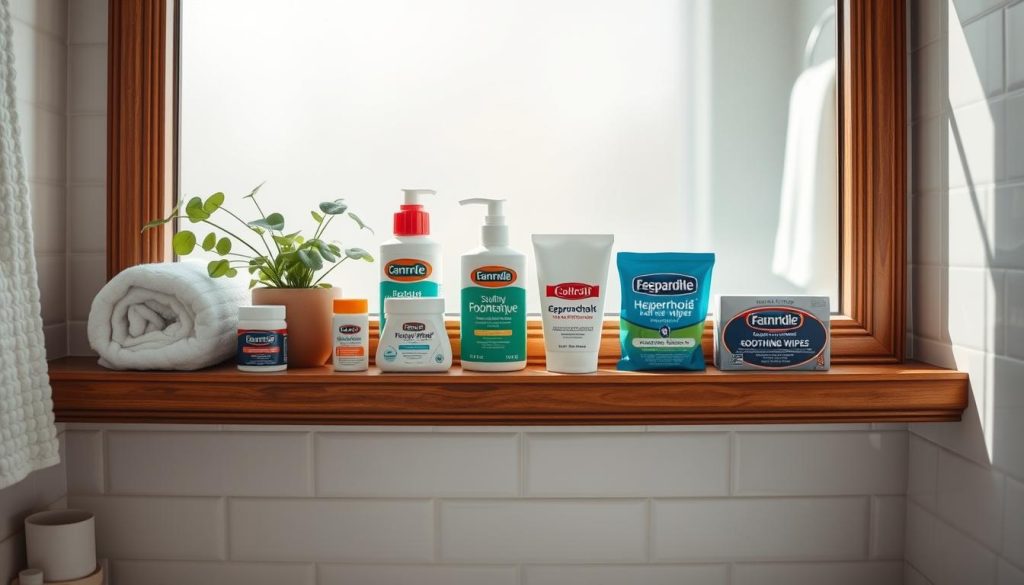
| Product Type | Key Ingredient | Purpose | Usage |
|---|---|---|---|
| Topical Cream | Hydrocortisone | Reduce inflammation | Apply up to 4 times daily |
| Cooling Gel | Witch Hazel | Soothe irritation | Apply as needed |
| Stool Softener | Docusate Sodium | Ease bowel movements | Take daily with water |
| Fiber Supplement | Psyllium Husk | Bulk-forming | Mix with water, drink immediately |
The Role of Hydration in Hemorrhoid Management
It’s important to understand how hydration helps with natural remedies for hemorrhoids. Drinking enough water keeps your digestive system healthy. This leads to softer stools, which helps avoid the straining that makes hemorrhoids worse.
Drinking water is a simple yet powerful hemorrhoid treatment option. It makes bowel movements smoother, reducing irritation from constipation and straining. Staying hydrated keeps your stool soft, making it easier to pass without putting pressure on hemorrhoid areas.
“Ensuring regular and sufficient water intake daily can greatly alleviate the painful symptoms associated with hemorrhoids.”
For more detailed insights into the significant role of water intake in managing this condition, consider browsing through a credible source on the management of hemorrhoids.
Here’s a practical guide on how to integrate hydration into your daily routine for effective hemorrhoid management:
- Start your day with a glass of water on an empty stomach to activate your digestive system.
- Carry a water bottle and sip regularly throughout the day, ensuring at least 8-10 glasses of water.
- Include water-rich foods like cucumbers, apples, and watermelon in your diet.
This approach not only aids in managing hemorrhoids but also contributes to overall health and well-being.
Best Practices for Bowel Movements to Prevent Hemorrhoid Flare-ups
Managing chronic conditions like hemorrhoids often starts with healthy bowel habits. Knowing how to reduce strain during bowel movements helps ease discomfort. Using hemorrhoid home remedies and informed practices can help treat hemorrhoids well.
Toilet Habits to Reduce Strain
Optimizing toilet use is key to avoiding hemorrhoid flare-ups. Simple changes in posture and timing can greatly help. For those with hemorrhoids, sitting less and keeping the right posture can ease pressure and pain.
Proper Cleaning Techniques for Hemorrhoid Sufferers
After using the bathroom, gentle cleaning is crucial to avoid irritation. Soft, unscented wipes or lukewarm water can help. These steps are important for managing hemorrhoid symptoms.
| Technique | Description | Benefits |
|---|---|---|
| Optimal Sitting Posture | Sitting upright with knees higher than hips using a footstool | Reduces strain by aligning the rectum for easier passage |
| Gentle Cleaning | Use of unscented wipes or a bidet | Minimizes irritation to sensitive areas, reducing risk of infection |
| Limited Toilet Time | Avoid prolonged sitting; ideally less than 5 minutes | Decreases pressure on anal and rectal veins |
These practices help manage hemorrhoids now and prevent future issues. Learn and use these techniques to improve your life and manage hemorrhoid symptoms better.
Natural Remedies for Hemorrhoids Worth Trying
Looking into natural remedies for hemorrhoids can help ease pain. Many people find relief with these methods. They are backed by some research and lots of personal stories.
Aloe Vera is known for its calming and anti-inflammatory effects. You can apply it directly to the affected area. Apple cider vinegar, used in small amounts, can also help reduce swelling and pain. But, make sure to dilute it to avoid skin irritation.
Herbal teas like chamomile or witch hazel can be used as compresses or in baths. They help reduce inflammation and soothe the area.
It’s important to use these treatments carefully. Make sure to apply them gently and test a small area first. This helps avoid any bad reactions.
- Aloe Vera Gel: Cooling and soothing, ideal for external application.
- Apple Cider Vinegar: Dilute and apply briefly for swelling reduction.
- Herbal Teas: Use as a compress or in sitz baths for gentle relief.
These natural remedies for hemorrhoids are easy to find and can work well. Always talk to a healthcare provider before trying them. This ensures they’re safe for you.
When to Consider Surgery: Medical Interventions for Hemorrhoids
Some cases of hemorrhoids need medical interventions for hemorrhoids. This is true when other treatments don’t work or when hemorrhoids are too big, painful, or bleed a lot. In these cases, surgery is often the best treatment for hemorrhoids. We’ll look at two common surgeries: rubber band ligation and sclerotherapy, among others.
Understanding Rubber Band Ligation
Rubber band ligation is a common treatment for hemorrhoids. It involves putting a tight rubber band around the base of a hemorrhoid. This cuts off its blood supply. Within a week, the hemorrhoid shrinks and falls off. It’s often used for internal hemorrhoids and is effective for many people.
Exploring Sclerotherapy and Other Surgical Options
Sclerotherapy is another option. It involves injecting a chemical solution into the hemorrhoid to shrink it. This method is good for smaller hemorrhoids and is usually done in a doctor’s office. It’s quick and often painless. Other surgeries, like hemorrhoidectomy and stapling, are also available. These remove or reduce hemorrhoids permanently.
| Procedure | Description | Typical Use Case |
|---|---|---|
| Rubber Band Ligation | Placement of rubber bands around hemorrhoids to cut off blood supply. | Internal hemorrhoids. |
| Sclerotherapy | Injection of a solution that shrinks the hemorrhoid. | Smaller or less severe hemorrhoids. |
| Hemorrhoidectomy | Surgical removal of hemorrhoids. | Large or severely symptomatic hemorrhoids. |
| Hemorrhoid Stapling | Procedure to block blood flow to hemorrhoidal tissue. | Internal hemorrhoids prone to prolapse or bleeding. |
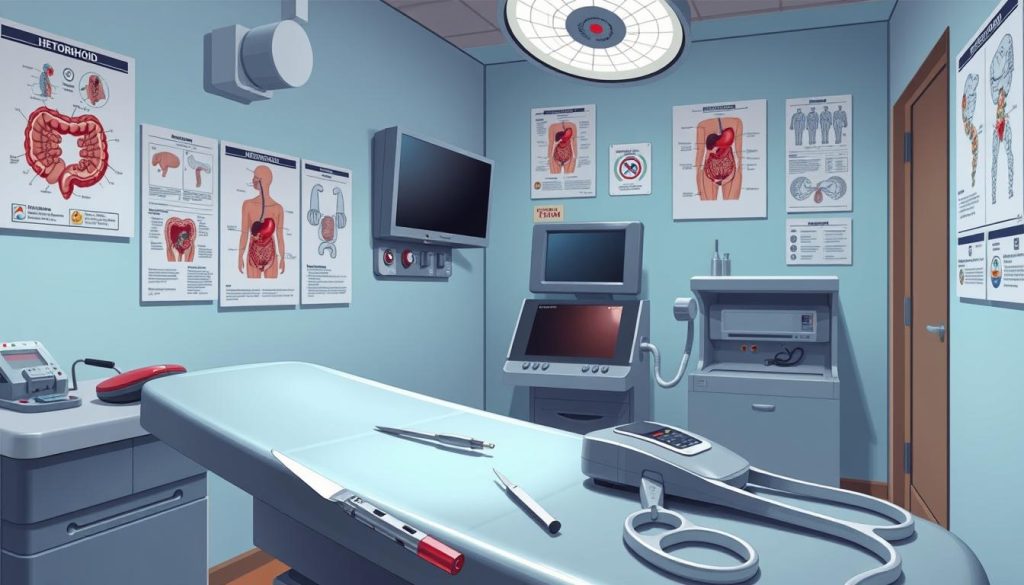
Advice for a Hemorrhoid-Friendly Lifestyle
Living a lifestyle that supports good blood flow and digestion is key to managing and preventing hemorrhoids. Our daily habits can greatly affect our risk and severity of hemorrhoids. Here are some simple tips to help with hemorrhoid treatment options and improve your overall health.
- Engage in Regular Physical Activity: Exercise boosts bowel movement and lowers vein pressure around the anus. This can stop new hemorrhoids or make existing ones worse.
- Ergonomic Seating Solutions: If you sit for long periods, use ergonomic chairs with good lumbar support. This can help avoid hemorrhoids by easing pelvic pressure.
- Effective Stress Management: Stress can upset digestion and worsen hemorrhoids. Yoga, meditation, and regular exercise can help lower stress and its effects on your body.
| Strategy | Benefits | Implementation |
|---|---|---|
| Regular Exercise | Improves digestion, reduces pressure | Aim for at least 30 minutes a day |
| Ergonomic Seating | Decreases pelvic pressure | Use chairs with adjustable features |
| Stress Management | Minimizes digestive disturbances | Incorporate relaxation techniques daily |
By focusing on these important areas, you can help prevent hemorrhoids and support ongoing hemorrhoid treatment options. Making these small changes can have big health benefits and improve your life quality.
Hemorrhoid Pain Relief: Tips and Tricks
Finding ways to ease hemorrhoid pain can make a big difference in your daily life. This guide will share some easy tips for treating hemorrhoids at home. We’ll focus on comfort, positioning, and exercises that won’t make things worse.
Comfort Measures and Positioning
Changing how you sit and sleep can help a lot. By easing pressure on the painful area, you can reduce pain and stop further irritation:
- Lie on your side instead of your back to cut down on vein pressure.
- Use a donut pillow when sitting to avoid direct pressure on the area.
- Keep the anal area clean and dry with soft, fragrance-free wipes or a bidet.
These tips are key to treating hemorrhoids at home effectively.
Exercise and Hemorrhoids: What You Need to Know
Exercise is important for managing and preventing hemorrhoid problems. It helps blood flow, reduces swelling, and speeds up healing. Here are some exercises good for people with hemorrhoids:
- Walking at a gentle pace for 20-30 minutes daily can help reduce vein pressure.
- Kegel exercises strengthen the pelvic floor, supporting the anal and rectal areas.
- Avoid heavy lifting and activities that strain the lower body and pelvic area.
Adding gentle exercise to your routine is a great way to relieve and prevent hemorrhoid pain.
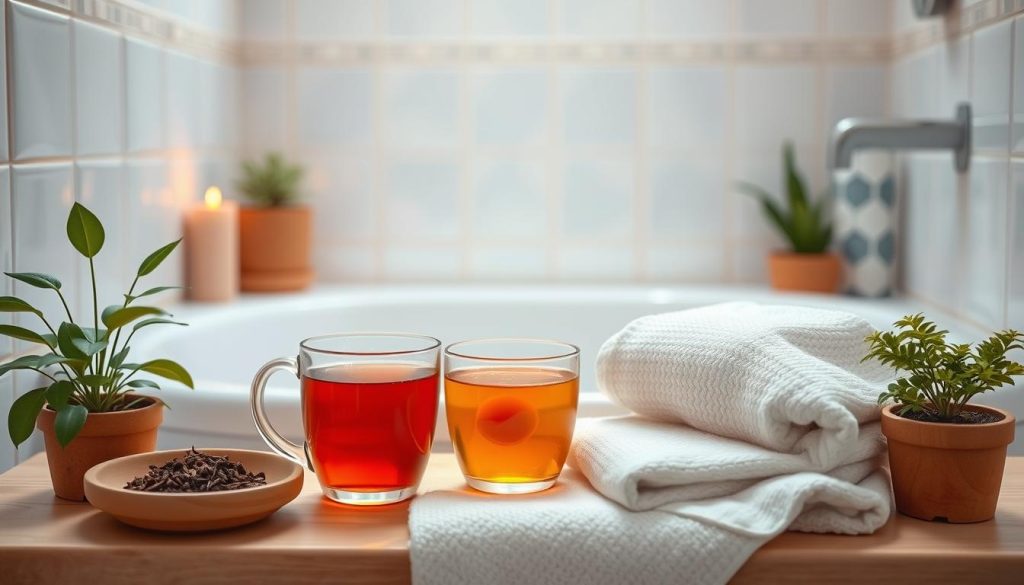
The Importance of Follow-up: When to See a Doctor
Knowing when to see a doctor for medical interventions for hemorrhoids is key. Many cases can be treated at home. But, some symptoms need a doctor’s care to avoid serious problems.
Signs like persistent pain, changes in bowel habits, or bleeding that won’t stop are warning signs. These could mean something serious like colorectal cancer. Don’t ignore them.
If home treatments don’t help, it’s time to talk about medical interventions for hemorrhoids. Doctors might suggest rubber band ligation or surgery for lasting relief.
Learning about symptoms related to acid reflux can also help you understand hemorrhoids better. This knowledge is found at healthwith.com.
- Continuous or excessive bleeding
- Non-reducing hemorrhoidal swelling
- Signs of infection such as fever or unusual discharge
- Anemia symptoms due to chronic blood loss
If you see any of these symptoms, see your doctor right away. They can help with the right medical interventions for hemorrhoids.
Hemorrhoid Treatment at Home vs. Professional Care
Choosing between natural remedies and professional treatments for hemorrhoids can be tough. Knowing how bad your condition is helps decide the best way to treat it.
Assessing the Severity of Your Hemorrhoids
It’s important to figure out how bad your hemorrhoids are. If they’re just a little uncomfortable and don’t bother you often, home treatments might work. But if you’re in a lot of pain all the time, you might need to see a doctor.
Home Treatments vs. Clinical Treatments: A Comparison
Home and professional treatments have their own benefits, depending on your hemorrhoids. Here’s a quick look at what each offers:
| Treatment Type | Effectiveness | Cost | Potential Side Effects | Long-term Outcomes |
|---|---|---|---|---|
| Home Remedies | Effective for mild cases | Low | Minimal | Good with proper management |
| Professional Care | Highly effective for severe cases | Higher | Varies with treatment | Excellent with follow-up |
When deciding between home remedies and professional treatments, think about how bad your symptoms are. Also, consider your own situation. Talking to a healthcare provider can help make the right choice for you.
Conclusion
Effective hemorrhoid relief methods are varied and easy to find. From recognizing symptoms to trying home remedies and professional treatments, a personalized approach is key. Making dietary changes, using over-the-counter products, staying hydrated, and practicing good bowel habits can help reduce symptoms.
Home remedies like warm baths and cold packs offer quick relief. They provide comfort physically and mentally. Along with a healthy diet and regular exercise, they help create a better environment for your colon. It’s important to know when to seek medical help for severe cases.
This guide shows that patients can take charge of their recovery. They have many tools and techniques to manage hemorrhoid pain. By focusing on individual treatment plans and combining home remedies with expert advice, readers can improve their colorectal health. This proactive approach can lead to lasting relief and better overall health.
FAQ
Q: What are some effective hemorrhoid treatment options?
A: Treatments for hemorrhoids include home remedies like warm sitz baths and creams. Medical options like rubber band ligation and surgery are also available, depending on the severity.
Q: Can lifestyle changes help with hemorrhoid relief?
A: Yes, making lifestyle changes can help. Eating more fiber, staying hydrated, exercising, and improving toilet habits can aid in relief and prevention.
Q: What are some natural remedies for hemorrhoids?
A: Natural remedies include aloe vera, witch hazel, apple cider vinegar, and herbal teas. They help because of their anti-inflammatory and soothing effects.
Q: What are the best treatment practices for hemorrhoids at home?
A: At-home treatments include keeping the area clean and using ice packs. Also, use unscented wipes and gently push back any prolapsed hemorrhoids. Over-the-counter creams and pads can also help with symptoms.
Q: When should one seek medical interventions for hemorrhoids?
A: Seek medical help if home treatments don’t work, symptoms get worse, or if there’s a lot of bleeding or pain. A doctor can offer treatments like procedures or surgery.
Q: How can dietary changes help in the treatment of hemorrhoids?
A: Eating a diet rich in fiber can make stools softer. This reduces straining during bowel movements, which helps treat and prevent hemorrhoids.
Q: Can over-the-counter products provide hemorrhoid pain relief?
A: Yes, products like creams and pads can help. They reduce inflammation, protect the skin, and ease pain and itchiness.
Q: What role does hydration play in managing hemorrhoids?
A: Drinking enough water makes stool softer. This helps prevent straining, which can make hemorrhoids worse. It’s key for managing and preventing them.
Q: What are the best bowel movement practices to prevent hemorrhoid flare-ups?
A: To prevent flare-ups, use the right toilet posture and avoid straining. Don’t stay on the toilet too long. Good anal hygiene and soft wipes also help.
Q: Are there any effective exercises for hemorrhoid sufferers?
A: Yes, exercises like walking and Kegels can help. They improve circulation and strengthen muscles around the anus, helping to prevent and alleviate hemorrhoids.
Q: Is surgery always necessary for treating hemorrhoids?
A: No, surgery is not always needed. It’s usually considered for severe cases where other treatments have failed or if complications arise.
Q: When is it crucial to see a doctor about hemorrhoid symptoms?
A: See a doctor for severe pain, a lot of bleeding, or if symptoms don’t get better with home care. These could be signs of a serious condition.
Q: How do I know if I should treat my hemorrhoids at home or seek professional care?
A: If your symptoms are mild to moderate, home treatments might work. But if they’re severe or don’t improve, you should see a doctor.












